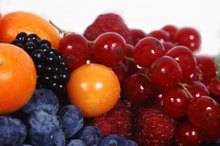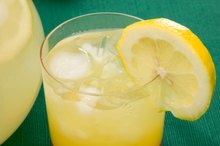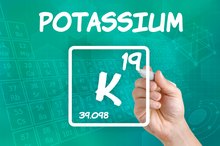What does fact checked mean?
At Healthfully, we strive to deliver objective content that is accurate and up-to-date. Our team periodically reviews articles in order to ensure content quality. The sources cited below consist of evidence from peer-reviewed journals, prominent medical organizations, academic associations, and government data.
- MedlinePlus: National Library of Medicine: NIH: Hypokalemia
- MedlinePlus: National Library of Medicine: NIH: Potassium in diet
The information contained on this site is for informational purposes only, and should not be used as a substitute for the advice of a professional health care provider. Please check with the appropriate physician regarding health questions and concerns. Although we strive to deliver accurate and up-to-date information, no guarantee to that effect is made.
Potassium Deficiency & Severely Dry Skin
Potassium is an electrolyte. Electrolytes are responsible for communicating information between various parts of the body. They do their job by passing around electrical charges through which information is relayed. Potassium carries a strong charge and is essential to every biochemical function of the body. Severely dry skin is a symptom of potassium deficiency and shouldn’t be ignored.
Hypokalemia
Hypokalemia is the medical term for potassium deficiency. According to the National Institutes of Health, or NIH, diuretics are the most common cause of deficiency, although certain antibiotics can also cause problems. Because potassium electrolytes reside in water, any illness or activity causing excessive dehydration poses problems. Diarrhea, vomiting and the eating disorder bulimia can all lead to hypokalemia. The NIH also cautions that consuming large amounts of licorice made with glycyrrhetinic acid will deplete potassium. Although glycyrrhetinic acid is no longer used in the United States in making licorice, the acid may be lurking in herbal teas and chewing tobacco.
- Hypokalemia is the medical term for potassium deficiency.
- The NIH also cautions that consuming large amounts of licorice made with glycyrrhetinic acid will deplete potassium.
Dietary Potassium
Potassium Chloride Vs. Potassium Gluconate
Learn More
Potassium consumed in the diet exists as a mineral compound. Bananas are perhaps the most widely recognized food that is high in potassium. When you eat a banana and it enters the stomach, the compound is broken down and the pure potassium mineral is released. In the presence of water, the mineral takes on an electrical charge and becomes a potassium ion, or electrolyte. Other foods high in potassium include all meats, potato skins, and broccoli. The Institute of Medicine recommends that adults consume 4,700 milligrams a day of potassium.
- Potassium consumed in the diet exists as a mineral compound.
- The Institute of Medicine recommends that adults consume 4,700 milligrams a day of potassium.
Xeroderma
Xeroderma is the medical term for dry skin and is an alarming symptom when associated with potassium deficiency. Potassium correlates highly with skin hydration and elasticity. If there is not enough potassium in the body, not only will the skin dehydrate, but it will also harden. Dehydration and hardening is not limited to the skin, and when caused by potassium deficiency, it affects all organs of the body, including life-sustaining organs such as:
- the heart
- kidney
- liver
- Xeroderma is the medical term for dry skin and is an alarming symptom when associated with potassium deficiency.
- If there is not enough potassium in the body, not only will the skin dehydrate, but it will also harden.
Prevention
Acid Forming Foods Vs. Alkaline Forming Foods
Learn More
Potassium is abundant in foods and deficiency as a result of inadequate diet is rare. However, new social behaviors and medications present unexpected challenges. For example, the journal "Critical Care and Resuscitation" reports on an emerging trend in the case study of a patient suffering profound hypokalmia 5. The patient was taking an ibuprofen and codeine pain reliever while consuming large quantities of a caffeine-containing energy drink. The article advises physicians to be alert to these emerging social trends.
- Potassium is abundant in foods and deficiency as a result of inadequate diet is rare.
- However, new social behaviors and medications present unexpected challenges.
Related Articles
References
- “Critical Care Clinics”; Disorders of potassium homeostasis. Hypokalemia and hyperkalemia; FJ. Gennari; April, 2002
- MedlinePlus: National Library of Medicine: NIH: Hypokalemia
- MedlinePlus: National Library of Medicine: NIH: Potassium in diet
- “Journal of Investigative Dermatology”; Relationship Between NMF (Lactate and Potassium) Content and the Physical Properties; N. Nakagawa, et.al.; March, 2004
- ”Critical Care and Resuscitation”; Profound hypokalaemia due to Nurofen Plus; D. Ernest, et. al.,; June, 2010
- Potassium. Office of Dietary Supplements. National Institutes of Health
- Lambert H, Frassetto L, Moore JB, et al. The effect of supplementation with alkaline potassium salts on bone metabolism: a meta-analysis. Osteoporos Int. 2015;26(4):1311-8. doi:+10.1007/s00198-014-3006-9
- Chatterjee R, Slentz C, Davenport CA, et al. Effects of potassium supplements on glucose metabolism in African Americans with prediabetes: a pilot trial. Am J Clin Nutr. 2017;106(6):1431-1438. doi:10.3945/ajcn.117.161570
- Potassium. Fact Sheet for Consumers. Office of Dietary Supplements. National Institutes of Health
- Health Claim Notification for Potassium Containing Foods. US Food and Drug Administration
- Aburto NJ, Hanson S, Gutierrez H, Hooper L, Elliott P, Cappuccio FP. Effect of increased potassium intake on cardiovascular risk factors and disease: systematic review and meta-analyses. BMJ 2013;346:f1378.
- Academy of Nutrition and Dietetics. What Is Potassium?
- ConsumerLab.com. Potassium Supplements Review.
- Curhan GC, Willett WC, Rimm EB, Stampfer MJ. A prospective study of dietary calcium and other nutrients and the risk of symptomatic kidney stones. N Engl J Med 1993;328:833-8.
- Curhan GC, Willett WC, Speizer FE, Spiegelman D, Stampfer MJ. Comparison of dietary calcium with supplemental calcium and other nutrients as factors affecting the risk for kidney stones in women. Ann Intern Med 1997;126:497-504.
- D’Elia L, Barba G, Cappuccio FP, Strazzullo P. Potassium intake, stroke, and cardiovascular disease a meta-analysis of prospective studies. J Am Coll Cardiol 2011;57:1210-9.
- O’Neil C, Keast D, Fulgoni V, and Nicklas T. Food sources of energy and nutrients among adults in the US: NHANES 2003-2006. Nutrients. 2012;4:2097-120. DOI: 10.3390/nu4122097.
- Stone M, Martyn L, and Weaver C. Potassium intake, bioavailability, hypertension, and glucose control. Nutrients. 2016;8: E444. DOI: 10.3390/nu8070444.
- U.S. Food and Drug Administration. Health Claim Notification for Potassium Containing Foods.
- Weaver CM. Potassium and health. Adv Nutr 2013;4:368S-77S.
- Yong Sun, et al. Dietary potassium regulates vascular calcification and arterial stiffness. JCI Insight. 2017;2(19):e94920.
Resources
Writer Bio
Larry Armstrong began writing articles professionally in 1986. These articles have appeared in scientific journals such as “Hypertension” and “American Journal of Therapeutics." He received his Doctor of Medicine from the Baylor College of Medicine in 1985. His fields of expertise include medical physiology and biochemistry.









